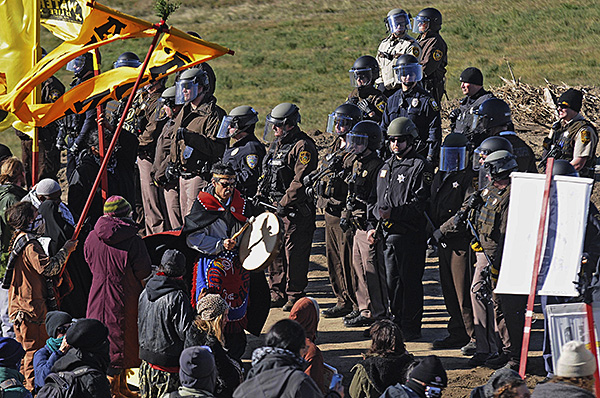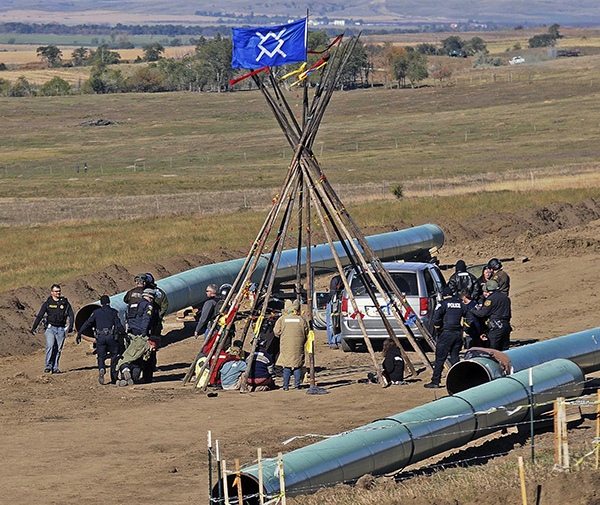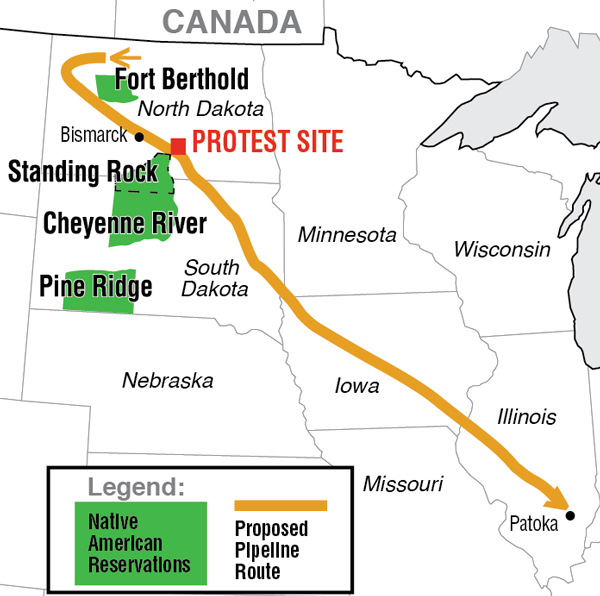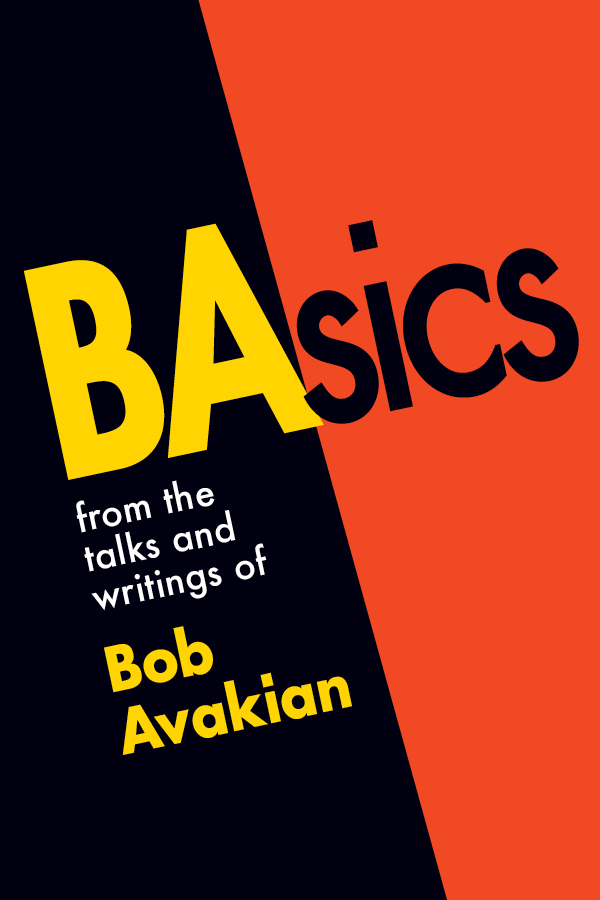
More than a thousand people gather at an encampment to protest Dakota Access oil pipeline near North Dakota's Standing Rock Sioux reservation. September 9. Photo: AP
High Stakes, Intensifying Confrontation at Standing Rock
October 17, 2016 | Revolution Newspaper | revcom.us

October 10 protest near Standing Rock, North Dakota, part of the battle to stop the Dakota Access Pipeline that endangers the water supply and encroaches on land that is precious to the traditions of the Native people in the area. (Photo: Tom Stromme/The Bismarck Tribune via AP)

Cops drag someone from the protest to stop the digging of the Dakota Access Pipeline, October 10. (Photo: Tom Stromme/The Bismarck Tribune via AP)
The Dakota Access Oil Pipeline (DAOP) threatens the water supply and tramples on burial grounds considered sacred by Native Americans at the Standing Rock Indian Reservation.
What started this summer as a defiant stand by a determined few at Standing Rock has drawn hundreds of Native tribes—including ones with longstanding historic conflicts—along with environmental activists and all kinds of people who have felt compelled to take a righteous stand. Thousands of people are now part of an encampment near the Standing Rock Reservation, determined to stop DAOP from encroaching on tribal lands.
The DAOP is a 1,200-mile monstrosity. DAOP begins where oil is extracted through environmentally devastating fracking in northern North Dakota, near—but on the U.S. side of—the Canadian border. On completion, DAOP will pump 500,000 more barrels of oil a day into the environment, escalating the global climate change crisis. In length and in the volume of oil capacity, DAOP is on the same scale as the Keystone XL pipeline. (See “Keystone XL Pipeline and the Deadly Calculations of Capitalism” for background.) DAOP hasn’t attracted the same level of international attention as Keystone XL, in part because it does not cross the U.S./Canada border.
High Stakes on Both Sides
Capitalist investors have $4 billion at stake in the completion of the Dakota Access Oil Pipeline.
Beyond that, the ruling class of the United States—whatever their conflicts over things like the role of coal, and whether or not to even acknowledge the climate crisis—are all committed to what they call U.S. “energy independence”—translation: increasing domestic fossil fuel extraction to gain strategic advantage over rival world powers, as part of dominating a world of exploitation and oppression.
The defiant stand of the heroic “water defenders,” as many at Standing Rock call themselves, has posed big questions about the nature of an oil-addicted system, and ongoing genocide against indigenous peoples, who are, to a great degree, fighting to survive in regions around the world targeted for capitalist resource exploitation.
Adding to the urgency at this juncture of the struggle is the prospect of the brutally cold Dakota winter, where temperatures often drop below minus 30 degrees, accompanied by ferocious Plains winds and large snow drifts. That will pose serious challenges for maintaining the encampment, as well as for pipeline construction.
Mass Arrests, Ratcheting Up Repression on October 10

This Revolution special issue focuses on the environmental emergency that now faces humanity and Earth’s ecosystems. In this issue we show:
- the dimensions of the emergency...
- the source of its causes in the capitalist system, and the impossibility of that system solving this crisis...
- a way out and way forward for humanity—a revolutionary society in which we could actually live as custodians of nature, rather than as its plunderers.
Read online....
Also available in brochure format (downloadable PDF)
Throughout the summer, protesters at Standing Rock have been subjected to a whole array of violent repression and terror. Local police have made dozens of arrests. Lawless company goons have set dogs on protesters in scenes reminiscent of police attacking Black civil rights protesters in the 1960s. And mainstream and Trump-style fascist media (which are barely distinguishable from each other in rural North and South Dakota) have whipped up a climate of violent hatred for “the Indians” among significant numbers of whites in the area, who are armed and openly threatening to Native Americans and those they perceive as supporting them. The New York Times characterized this side of the situation in a headline, “Ranchers Tote Guns as Tribes Dig In for Long Pipeline Fight.”
On October 9, the U.S. Court of Appeals for the D.C. Circuit denied the Standing Rock Sioux Tribe’s request for an injunction to halt pipeline construction. Energy Transfer Partners (ETP) immediately resumed construction, which had been temporarily halted.
The next day, October 10, the official federal “holiday” that celebrates the arrival of the genocidal colonialist invader Columbus, protesters were out confronting the pipeline crews. Mandan, North Dakota, police arrested 27 people engaged in peaceful protest (the Standing Rock Reservation straddles and includes significant territory on both sides of the North Dakota/South Dakota border). Most were jailed overnight and released later, and one has refused to be released on bail.
For background on the struggle at Standing Rock, see "Native Americans Fight Modern-Day Genocide: Standing Up at Standing Rock"

Revolution spoke with a member of the Red Owl Collective, an initiative of the National Lawyers Guild, which is providing volunteer legal services for water protectors. She told Revolution that the 27 people arrested on October 10 included an indigenous elder, and that a young woman was assaulted during her arrest. Another person arrested was an alderwoman from Madison, Wisconsin, who came to present a declaration of support from her city to tribal authorities. The activist with the Red Owl Collective, who has been encamped at Standing Rock since August, said, “The arrests are part of escalating tactics to put a chill on free speech and assembly.”
Actress Shailene Woodley was also among those arrested on October 10. In a livestream of her arrest, seen by several million people, she called out authorities for targeting her to send a message. Edward Snowden sent a solidarity message in response, as did Joseph Gordon-Levitt, who stars in the movie Snowden (Shailene Woodley co-stars in that movie).
In another outrageous move, on October 14, authorities announced they were moving to bring new and escalated “riot” charges against journalist Amy Goodman of Democracy Now! On Saturday, September 3, Amy Goodman filmed security guards working for the pipeline company attacking protesters with dogs and using pepper spray. Five days later she learned that a warrant was issued for her arrest. In addition, the Red Owl Collective representative told Revolution that an arrest warrant has been issued for a journalist for Digital Smoke Signals.
Describing the combination of arrests, company thugs, and the mobilization of armed racists, the Red Owl Collective activist told Revolution, “Everybody is concerned for their personal safety.”
Which Side Are You On?
The defiant and heroic stand of the protesters at Standing Rock—and the vicious repression they are up against—present a challenge to everyone to stand with and support this struggle. The rulers of the U.S. find themselves caught in an awkward situation that points to the history and present day reality of genocide against Native Americans, theft of their land, and plunder of resources in the areas supposedly set aside for them as “reservations.”
Indigenous activists from as far away as Ecuador and Hawai’i have been part of the encampment. They have been joined by thousands of others. In addition to the Madison City Council resolution referred to earlier, 18 other U.S. city governments have passed resolutions or written letters opposing construction of the Dakota Access pipeline including Seattle, Washington; Saint Paul and Minneapolis, Minnesota; Cleveland, Ohio; Portland, Oregon; Berkeley, Santa Barbara, and Oakland, California; Asheville, North Carolina; Sitka, Alaska; and Urbana, Illinois.
St. Louis, Missouri, said in its resolution: “Recent oil spills, including the release of 80,000 gallons of oil near Tioga, North Dakota in October 2013; 51,000 gallons of oil released into the Yellowstone River upstream from Glendive, Montana; as well as the release of 1,000,000 gallons of tar sands crude in Michigan’s Kalamazoo River in July 2010, demonstrate the danger for downstream communities, fish, and wildlife from oil from pipelines such as the Dakota Access.” (See “Standing With Standing Rock: 19 Cities Express Solidarity Against DAPL,” Indian Country Today Media Network.)
Support has come in from around the world, including delegations from Europe. On October 13, the Swedish parliament sent a letter to Barack Obama and other U.S. officials saying, “We strongly oppose the treatment of unarmed civilians and media persons, by police agencies and state authorities, that have been demonstrated these past weeks, since the protest against the Dakota Access pipeline started.”
On October 11, nine climate activists were arrested for attempting to shut down all tar sands oil coming into the United States from Canada by manually turning off pipelines in Minnesota, Montana, North Dakota, and Washington State. One of the protesters, Leonard Higgins, said, “We’re in a state of emergency to protect our loved ones and our families, our communities. We need to step up as citizens and take action where our leaders are not. That’s what I’m prepared to do when I close the valve.”
Conscious of the stakes from the perspective of representing a system of global exploitation and oppression, while branding itself a champion of human rights, and concerned with how all this looks to the world, the Obama administration has tried to maintain a face of impartiality in this standoff. In September, the U.S. Departments of Army, Justice, and Interior asked Energy Transfer Partners to stop construction within 20 miles on either side of the Missouri River while the Army Corps of Engineers conducted more review and promised to work with tribes who have called out the federal government for not consulting properly with them on the pipeline route.
In an interview with Revolution, journalist and Native American activist Simon Moya-Smith noted, “The Army Corps of Engineers is asking, they’re requesting, that the Dakota Access Pipeline be halted. These are not injunctions. These are requests. They’re just asking. And if they don’t stop, there’s no repercussions. So why would they stop?” And he said this is “like asking a dog that’s biting, speaking of dogs, right, to release when you know it won’t.”
Two sides are sharpening up at Standing Rock. There are high stakes for the battle against the ongoing genocide against indigenous peoples, and to defend this planet’s critically wounded environment.
Volunteers Needed... for revcom.us and Revolution
If you like this article, subscribe, donate to and sustain Revolution newspaper.








